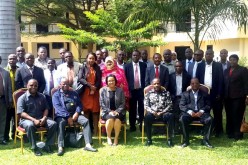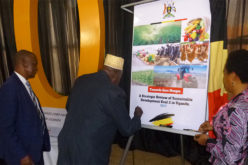by Florence Nakazi, Research Analyst, EPRC
This blog post looks at the impact of climate change on Uganda’s primary export crop-coffee. It gives recommendations on how the government could combat climate change and help the coffee industry achieve the 20 million bags target by 2020.
In late July, I was collecting household survey data from smallholder farmers in Bukomansimbi village in Masaka. This is a major Robusta coffee-producing district in Central Uganda. Normally, at this time of year, the rainy season would have just finished, and coffee trees would be ready for harvesting. But at the home of Ntambi Emmex, a 52-year-old farmer who supports his family with two acres of coffee, the leaves were brown, and a few cherries on trees were hard and black. “If it had rained, the coffee branches would be hanging down with cherries,” he said. “Now, my coffee has just become firewood.” As a result, Ntambi’s household is struggling to meet basic needs like health and education. Ntambi’s story is familiar to many coffee farmers in Uganda. It exemplifies how the country is grappling to achieve Sustainable Development Goal (SDG) 13, which calls for urgent action to combat climate change.
The Intergovernmental Panel on Climate Change (IPCC) summarizes climate change as: any change in climate over time, whether due to natural variability or as a result of human activity. Uganda’s rainy season is becoming increasingly unpredictable and long periods of drought have become normal. This is expected to worsen in several coffee growing areas. Coffee cultivation is spread towards marginal lands, where water shortage and unfavourable temperatures constitute major constraints to the coffee harvest. The variations in climate may be minimal, but the consequences for the coffee sub-sector are far reaching.
Sustainable Development Goal 13 (SDG 13) calls for urgent action to combat climate change. To Uganda specifically, the need to combat climate change and its effects on coffee is of strategic importance. Coffee is one of the country’s top exports. If not reduced, climate change could thwart Uganda’s target to increase annual coffee production from currently 4.6 million bags to 20 million (60 kg per bag) by 2020.
The government is working on achieving SDG 13 by creating certain policies, programmes, projects and interventions. The aim is to alleviate the impacts of climate change on coffee. Notable among these interventions is the use of drought resilient coffee varieties that are distributed under “Operation Wealth Creation”. The idea is to increase the survival rates of coffee seedlings. Another measure is the provision of weather information and forecast. This enables farmers to plan ahead for the cropping season. But despite these efforts, the percentage of farmers using drought resilient coffee varieties and fertilizers is less than 10%. The use of irrigation stands at less than 1%. This makes the coffee sub-sector highly susceptible to effects of climate change.
How is climate change affecting Uganda’s coffee sub-sector?
Climate change is having a negative impact on the coffee sub-sector in four ways:
- The survival rate of coffee seedlings, distributed under the coffee replanting programme, is declining. Between 2007 and 2016, Uganda lost coffee seedlings worth US$ 10 million. In 2015/16 alone, seedlings worth US$ 3 million did not germinate due to the drought.
- Gradual decrease in arable land favourable for Robusta coffee growth. Robusta coffee, which is low altitude coffee, makes up to 80% of Uganda’s coffee exports. With an increase in temperature of only 20C, traditional Robusta coffee growing regions will disappear and new regions (in higher altitude zones) will appear. This means that farmers at lower altitudes will no longer be able to produce coffee and will need to find new livelihoods.
- Constrained potential harvest attainable in a rain-fed low input production system to figures below the potential yield. Output has remained relatively constant at an average of 600 kg per hectare, which is lower than the documented potential of 2,100 kg per hectare.
- Reduced quality of Uganda’s coffee, which affects the amount of foreign earnings. Uganda mostly exports three coffee grades: Screen 15 (medium bean size), followed by Screen 12 (smallest bean size) and Screen 18 (biggest bean size). These sell for relatively low prices on the world market as compared to specialty coffee, due to the effects of drought.
How can coffee farmers adapt to climate change?
Given the devastating effects of climate change on coffee, farmers will have to cope with additional farm investments to adapt to climate change. One way to do this is having strong and effective institutional arrangements. These should guarantee stability in incomes from coffee and high returns on coffee farm investment. The farmer ownership model now provides a sustainable value chain adaptation strategy for sustainable coffee production.
The farmer ownership model piloted by the National Union of Coffee Agribusinesses and Farm Enterprises (NUCAFE), allows farmers to earn additional income from value added to the coffee at the various nodes of the chain. Such added incomes can counterbalance some of the costs invested in agricultural practices like irrigation and manure application. Once the coffee farmers are reasonably paid, they will be able to reinvest in quality improvement for better returns.
Achieving SDG 13
It is clear that climate change is a threat to Uganda’s primary export crop-coffee. So far the adaptation initiative has been government-driven, by providing drought resistant coffee varieties. But farmers need to be involved pro-actively as well. For Uganda to achieve its commitment of the 2030 Agenda and in particular SDG 13 in coffee production, the Uganda Coffee Development Authority (UCDA) and NUCAFE, should scale up the institutionalized mechanism of “farmer ownership”. This will increase farmers’ adaptability to climate change and the reinvestment in agricultural practices.
About the author:
Florence Nakazi is a Research Analyst with the Sectoral Department at the Economic Policy Research Center (EPRC). She holds a Master of Science in Agricultural and Applied Economics. She has been involved in various research areas, including agriculture, gender, value chains, and climate change. Twitter: @FlorenceNakazi
Southern Voice is a network of 50 think tanks from Asia, Africa and Latin America, researching on the UN Sustainable Development Goals (SDGs).
1,908 total views, 4 views today








